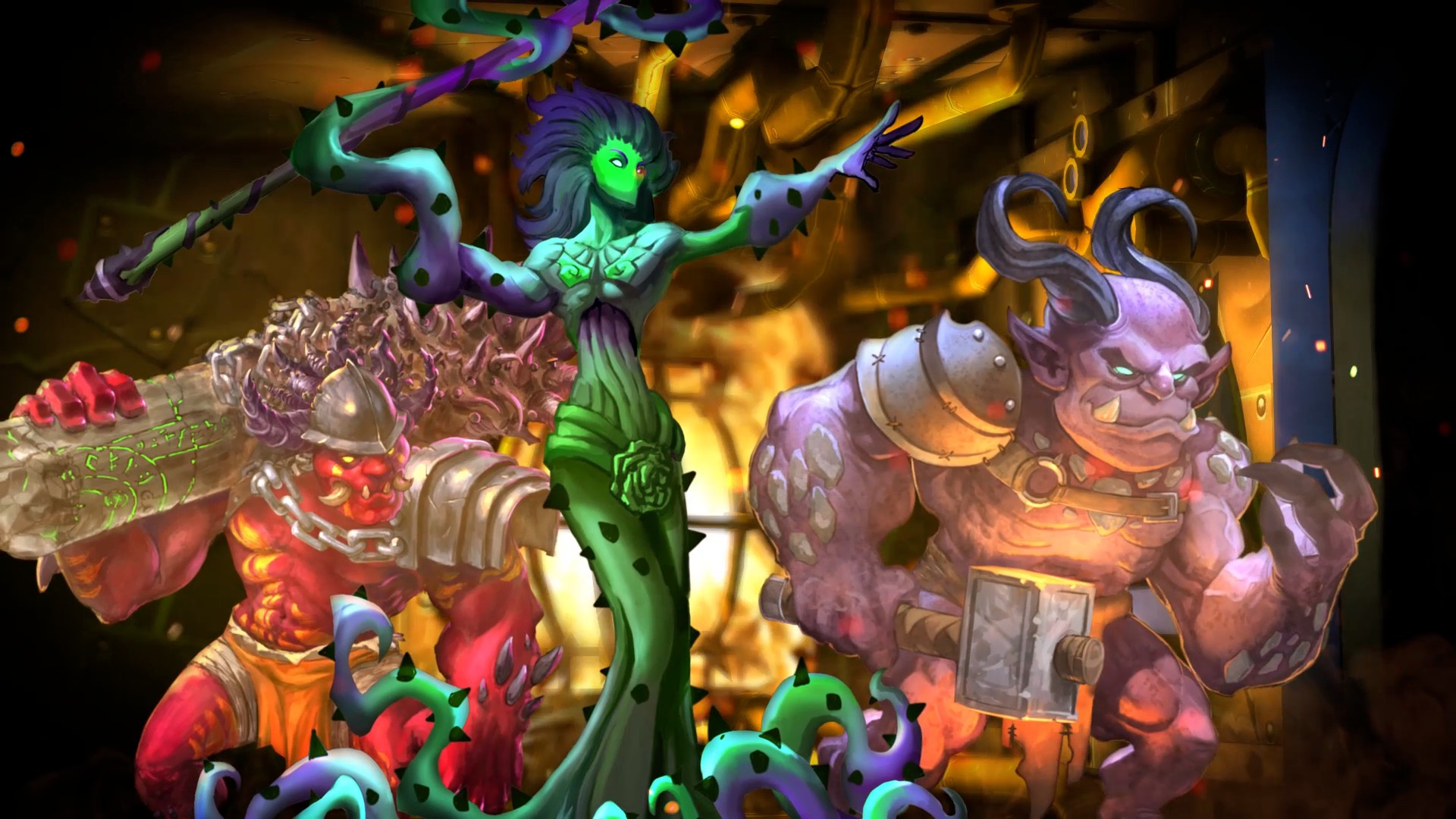
I had only been playing the demo for a few days, and I already knew we had to review this one. Deck building games, for the uninitiated, are card games where your discard pile is shuffled into a new deck when needed. As such, you turn your deck into an “engine” to acquire points.
Good Shepherd Entertainment and developer Shiny Shoe have taken that literally with their latest venture. Combining deck building with other card game mechanics and a little bit of tower defense, Monster Train came out of left field like a freight train out of hell. We’re so glad it did.
Monster Train
Developer: Shiny Shoe
Publisher: Good Shepherd Entertainment
Platforms: Windows PC (Reviewed)
Release Date: May 21st, 2020
Players: 1 (with online multiplayer elements)
Price: $24.99
The game’s introduction is the only real solid explanation into the game’s story, with lore on the various cards providing more depth and world building. In short, Heaven and Hell finally made peace with The Covenant, which lead to the numerous rings of hell uniting through the construction of a railway between them.
This peace soon ended with Seraph, betraying hell and aiding Heaven in their invasion. Now hell has frozen over, with only one Pyre- the source of heat and magical energy- remaining. This has been loaded up onto a train, which is now trying to reach the heart of hell to re-ignite the core.
Drip feeding players information about the world through new cards was a brilliant idea, giving yet more reason to be excited to unlock a new card. The plot could easily have been a basic vehicle for the gameplay, but there is something more for those who look.
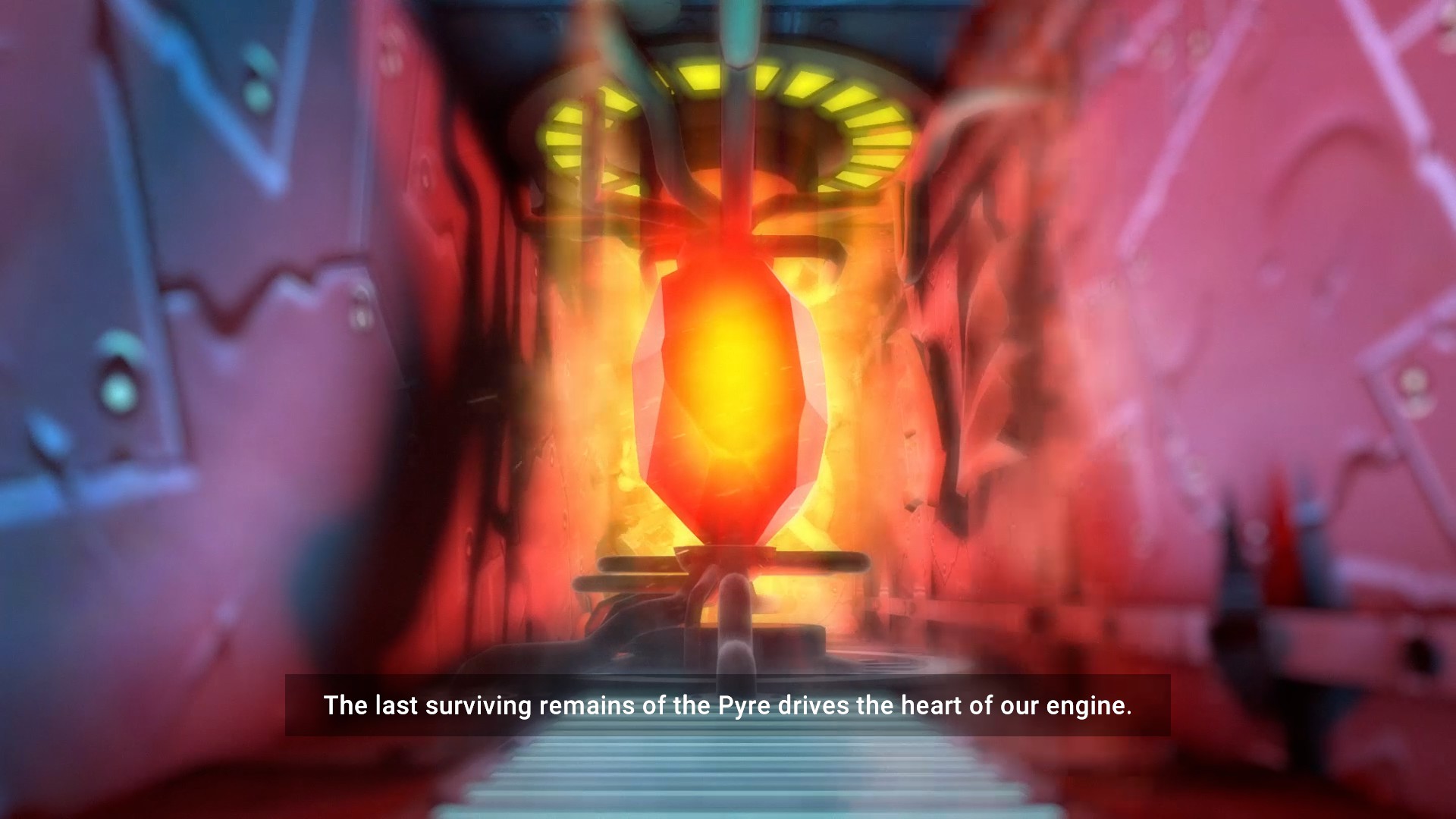
Gameplay is divided between battles, and choosing what tracks your train runs down. Battles take place within the train; three floors with another above that containing the Pyre.
Angels and other divine creatures will enter from the lowest level, climbing up each turn until they can start whacking hell out of the Pyre. While it can somewhat defend itself, players must add their own monsters to the lower levels and cast spells (each with their own “Ember” cost).
Not only are players tasked with fighting a battlefield on multiple fronts, but they must plan ahead. While the UI can show what health participants will lose in a battle, players will have to consider the effects and abilities in play that could have alter future turns.
Players can also see what cards remain in their deck, and are in their discard pile. Combined with all the effects on a card being explained when moused over, players have access to most of the information they would need, while still needing to use their little grey cells to be optimal.
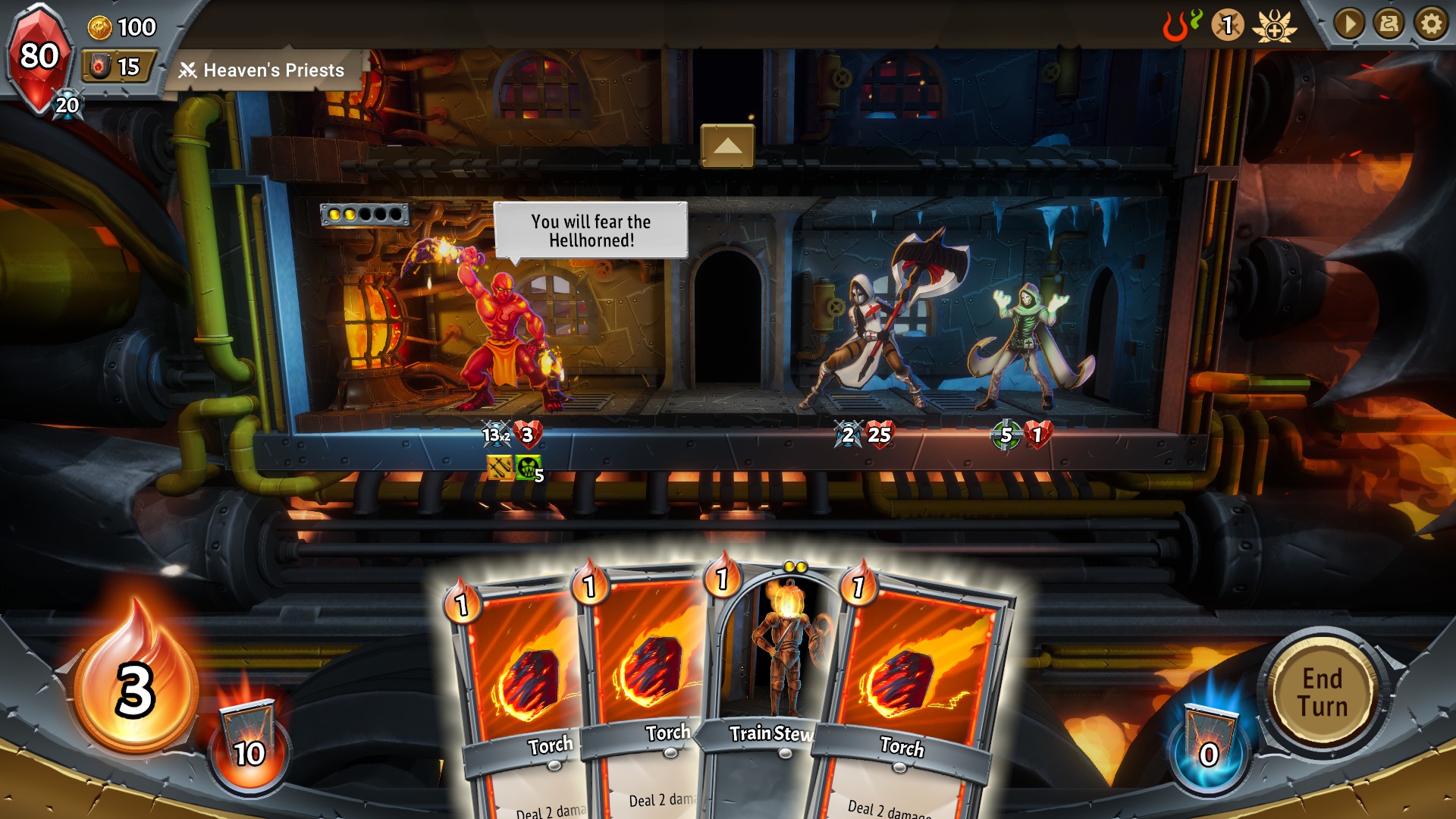
The game has five clans of monsters, each with their own play-style that unlock more cards as you level the faction up. Hellhorned are fast and aggressive traditional red-and-horned demons and imps. The Awoken are living plants that react to being attacked and when healed.
The underwater Lovecraftian Stygian Guard are heavily focused on spells and building up DOT damage. The shadowy Umbra summon smaller “morsel” units to feed bigger units. Finally, the Melting Remnant are religious fanatics and mobsters trying to keep alive longer, or sacrifice themselves for effects.
This overview only scratches the surface of each clan. While each have numerous strategies on their own, players pick two- a major and minor. This grants you the Champion and more cards of the former, and some cards from the latter. Ultimately, players have the chance to add more cards from both factions to their deck.
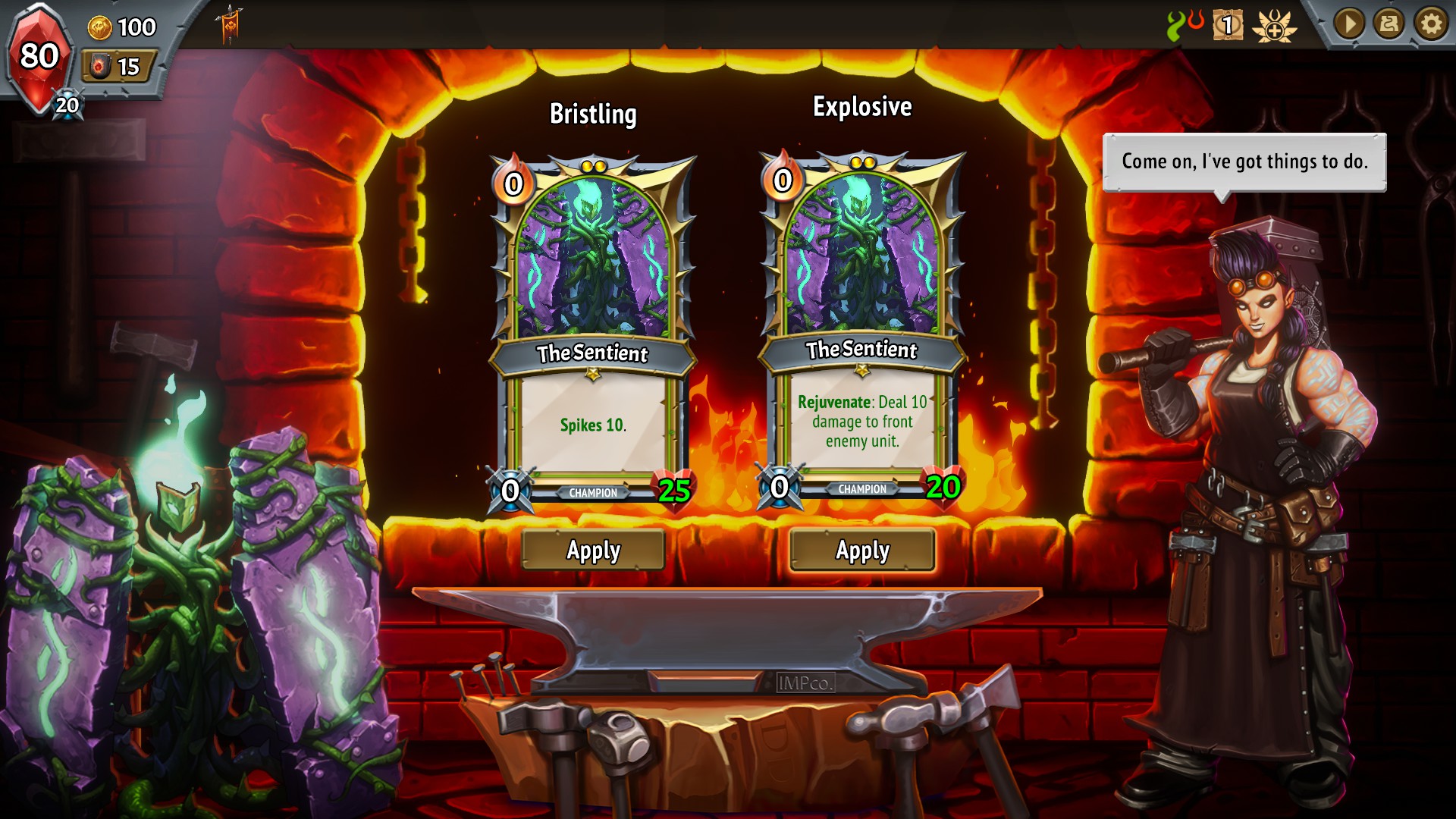
While the discard pile is shuffled when the deck is emptied, this does not include your monsters slain in battle (you get them back after though). Fighting angels is a war of attrition, attempting to kill them before they reach the top of the train.
All enemies attack first (striking your front line monsters), then your party acts. The AI tends to put monsters with armor on the front line with support at the back, though the spells and abilities at play can shuffle enemies around, or use damaging spells on any target.
Along with enemies having numerous abilities (and the temptation to make the battle even tougher with another modifier on top in exchange for rewards) bosses are “relentless”. They repeat the battle phase over and over until all foes on a floor are dead, or they are.
Do you place your best monsters at the top to make a last stand against weakened foes, or do you place your best at the front door? Beating a boss in the first carriage nets more points for your final score, but also more risk. Does your strategy work best against the chattel or the boss?
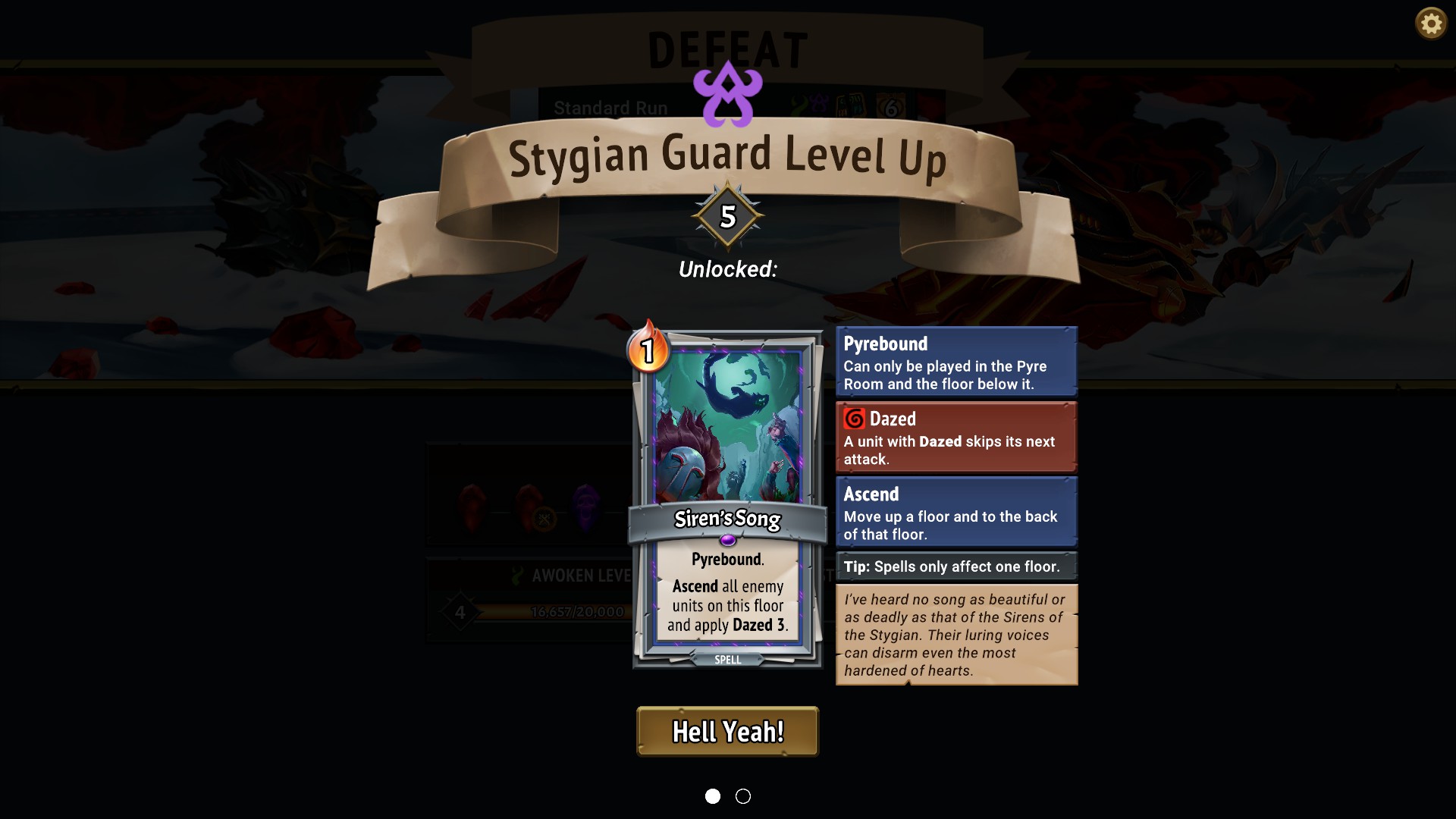
It’s these choices throughout that make the game incredibly moreish. The card selection is large enough (when combined with the abilities enemies can have) that no two playthroughs are ever the same. This is further augmented with artifacts, and the ability to modify cards at shops for that run.
Along with making cards cheaper to play or more powerful, there are some surprisingly powerful abilities you can add. Making a spell return to your hand when played, keeping a card that removes itself from the game when played, or making a card “consumable” to jack-up its power even higher.
There is also the slight exploit of being able to restart a battle from the beginning, by going to the main menu during a battle. If you play the same cards, they’ll come out in the same order at first. Some may consider this cheating, others a good way to re-balance the odds in their favor.
Whether by luck or well planned choices, it’s no surprise you can end up as nigh-unbeatable. I’ve been able to keep a permanent damage shields and stealth buffs on my allies, and cycled through my whole deck and played every card. I’ve even buffed stats until the final boss would blush.
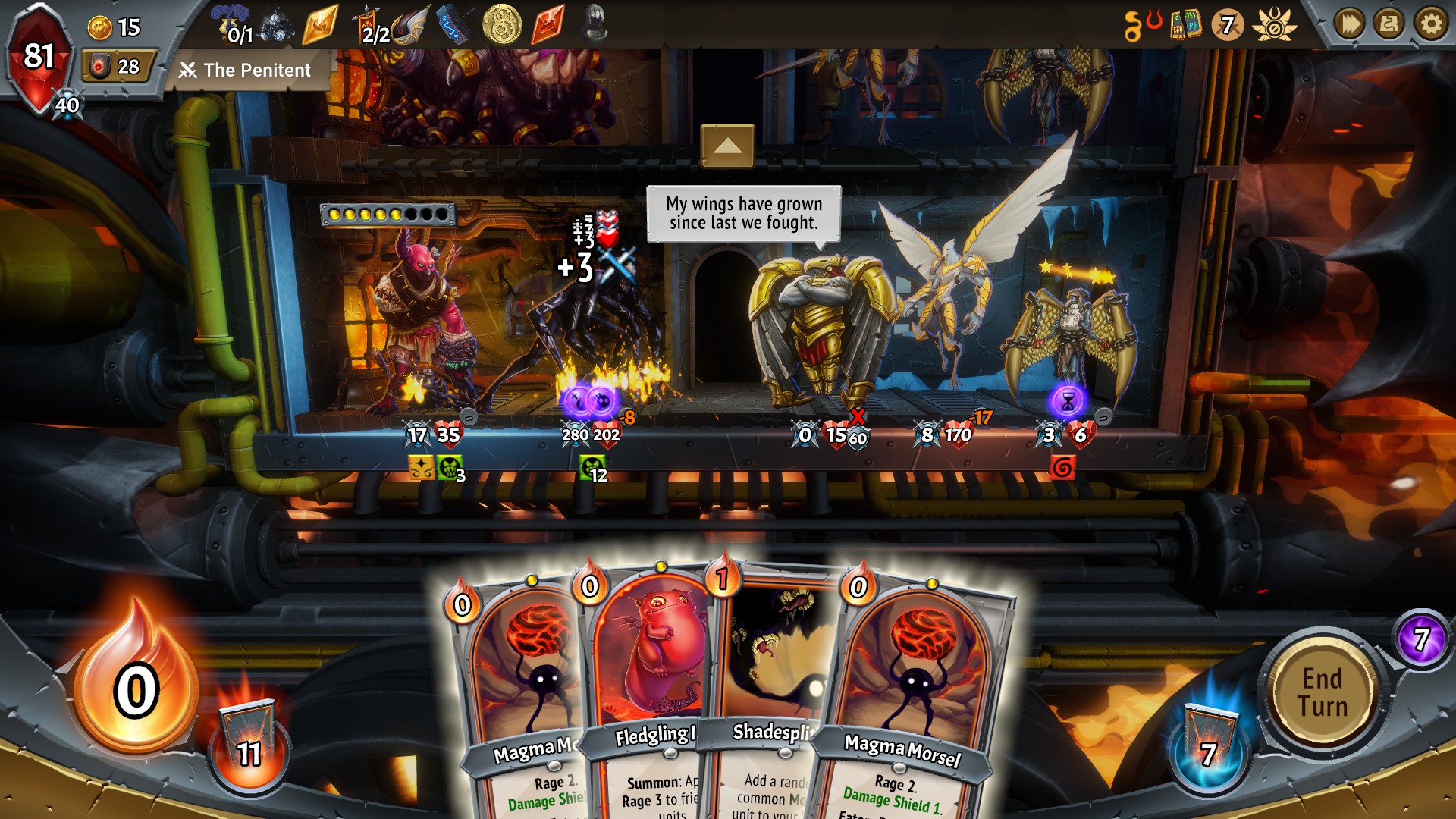
Speaking of, it was rather worrying when I beat the final boss within a few hours by doubling the frostbite DOT before it even entered the train. However this was due to good fortune and a low difficulty setting for that run. There is still a challenge here, and getting to the end of the line is not even always viable.
At the start of each run, you learn what the final boss’ passive ability will be. Once you’ve gotten your first few cards and artifacts, it can be frustrating to know your plans are already countered. Thankfully, you can quickly restart a run under the same parameters.
On the one hand, it can be infuriating to run into enemies and bosses who have an ability which perfectly disrupt the cards you have literally been dealt. On the other, it’s not always hopeless. Considering the nature of the game, it is surprising how little you are able to re-roll.
While you can re-roll (or restock) what the card upgrade shops have (once per shop), you can never spend your hard earned cash to re-roll the cards or artifacts you come across. Sure you can choose to take money in those instances instead, but raw cash can’t save you for when RNGesus has forsaken you.
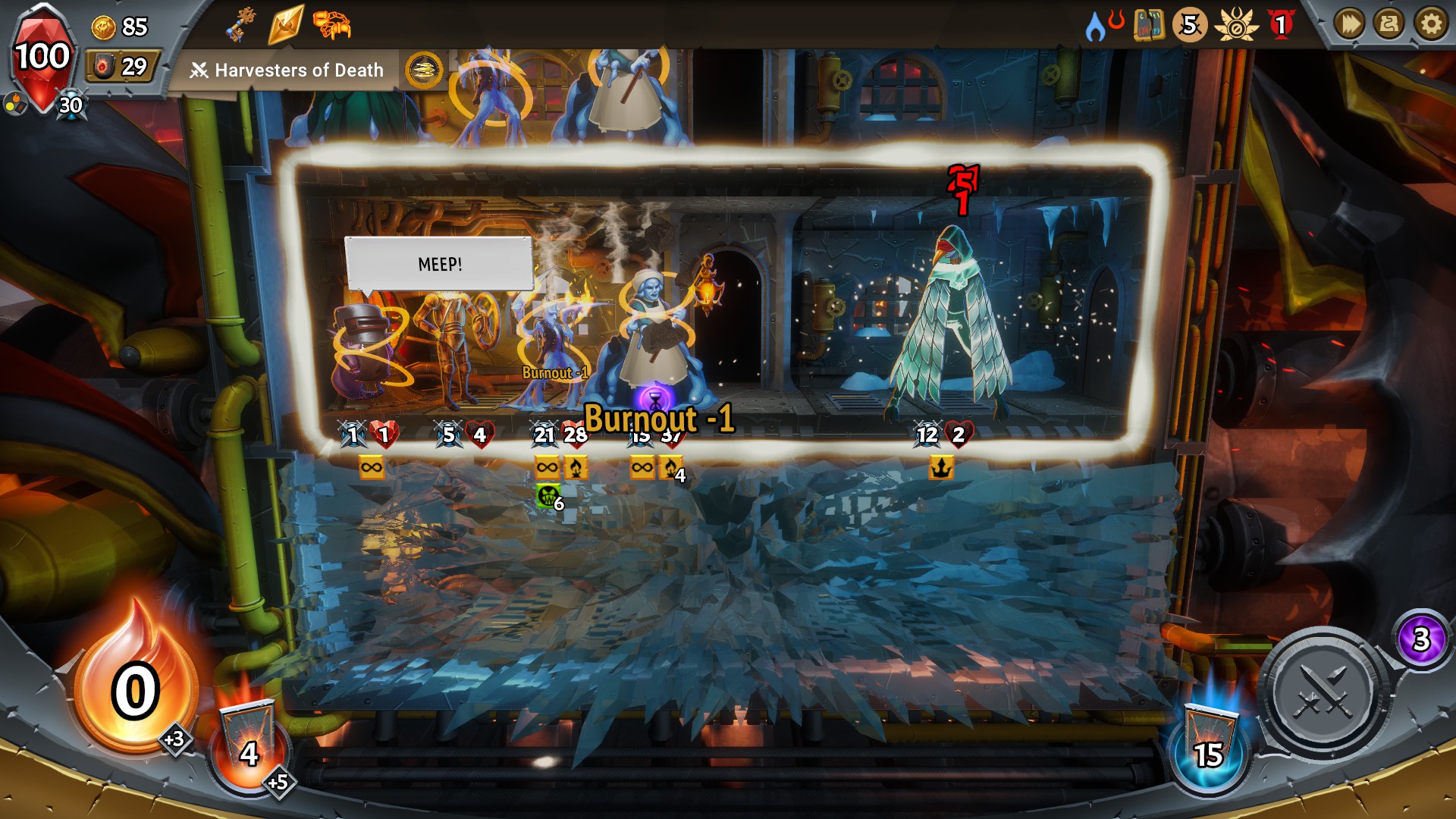
The higher difficulty levels are unlocked by completing runs. This does not always mean foes with better stats, but more enemies, more varied starting decks, and other hindrances to you.
Higher difficulties also unlock more powerful card upgrades in the shops, and completing a run with any card in your deck “masters” it, granting it a shiny gold border.
While enemies and bosses are widely varied, there are several major bosses that are the same boss every time. While they move between the floors outside the train for several turns (and can be attacked if there are no other foes), their gimmick is always the same (albeit with a modifier). This does mean you can plan for them more easily.
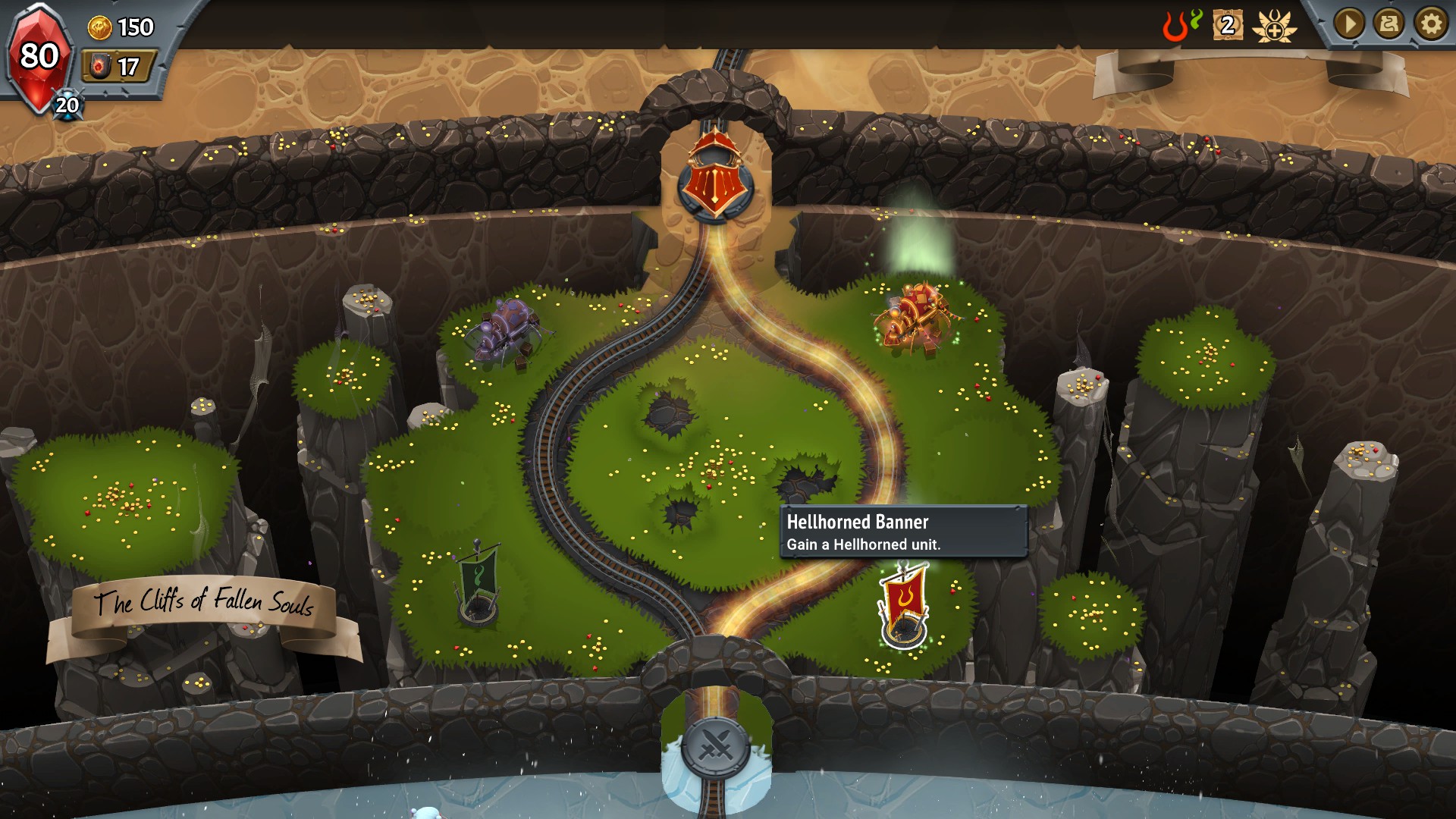
Aside from combat, players have got to get their train to the center of hell. Each ring of hell has two sets of tracks, with places to visit on either side. Players must choose which side to take in each area, and visit the buildings on en-route.
Here is where players can upgrade their cards at the aforementioned shops, pick up new units at banners, heal their Pyre, or delve into caves for random events.
Despite their name, the outcome of your choices in random events are shown 99.9% of the time. Players can also find nodes to remove cards from their deck to keep things lean, or duplicate a card- with its upgrades. This is where your almost game-breaking builds are born.
Combined with being able to see the entire map from the start, players can plan how their deck will develop almost as well as their plans in battle. You can even view the card errata via the logbook at any time! It is the crux of why the game encourages you to have another go, the potential to build a good deck.

Which is why the multiplayer aspect is so baffling. Hell Rush are essentially single player games where you can see the progress of other players. The game is constantly timed however, with a shockingly short time limit.
You will need to know all the cards effects off by heart, or risk the game auto-resolving your battles for you (and not playing any cards). While the game focuses on high-scores (even showing you the history of every run, the cards you used, and how they were upgraded), there is seemingly no online leaderboards for single player.
Players can create custom games for others (with unique modifiers across the whole run), but other than the daily challenge (essentially developer-made custom games), it isn’t as easy to share your bragging rights as it could be. The almost arcade-like nature of the game is begging for it.
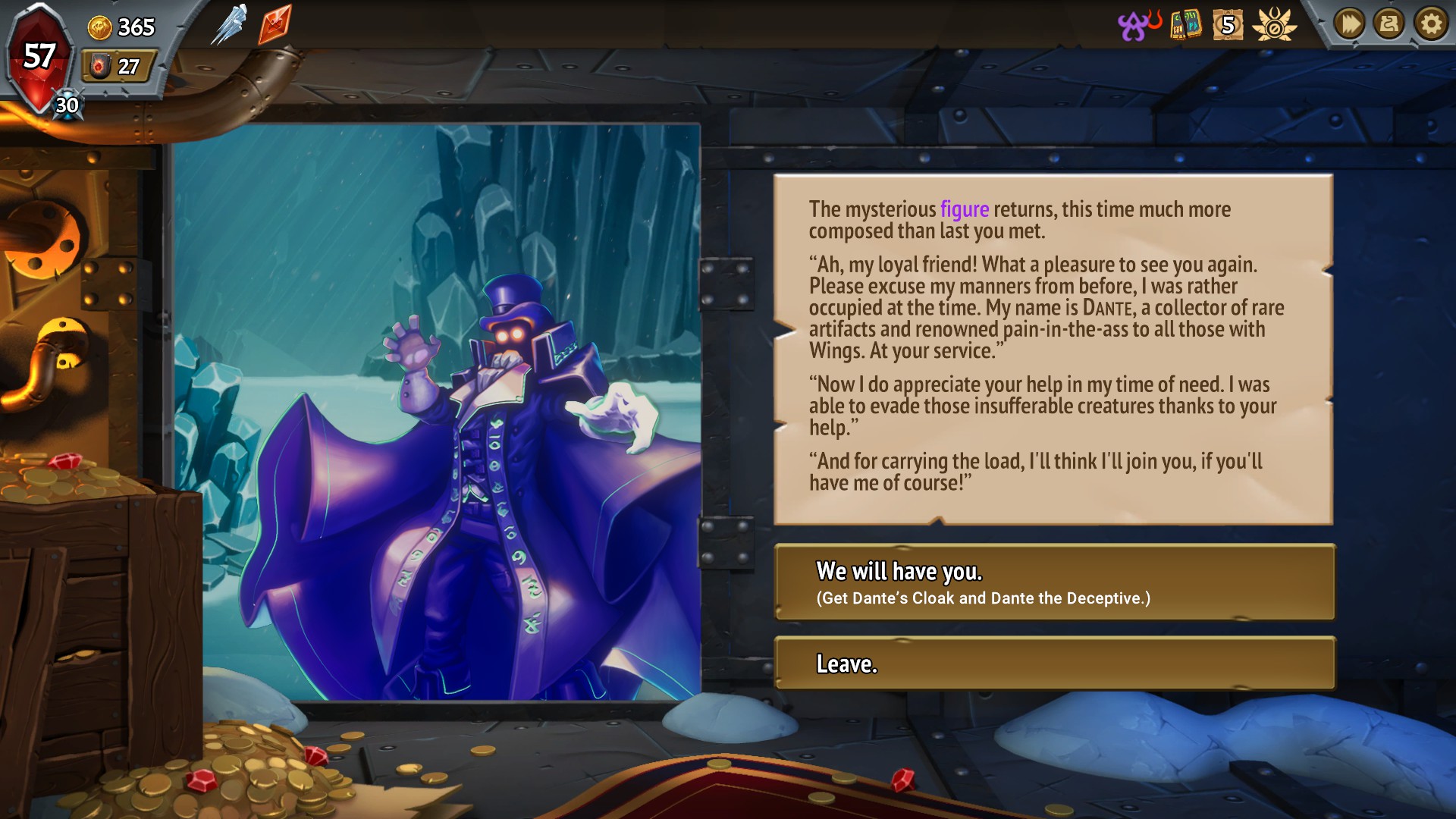
The game uses fantastically drawn characters, with some slight motion tweening to prevent them being static (and far more movement in the card art). Aside from the lore, the character’s appearances make you want to know more about each hell clan and the angels at a glance.
The fire and brimstone is just one small part of hell, making it one of the more interesting underworlds in media. Any clan’s designs and lore could have a whole game dedicated to them individually.
While the amount of enemies and monsters is reasonable (even those that use the same base design can have radically different features), foes can grow repetitive. Though by that point, you’ll be more concerned with the stats and figures.
As such, the designs have done the perfect job. You’ll soon remember at a glance what each monster, card, angel, and symbol on the UI can do.
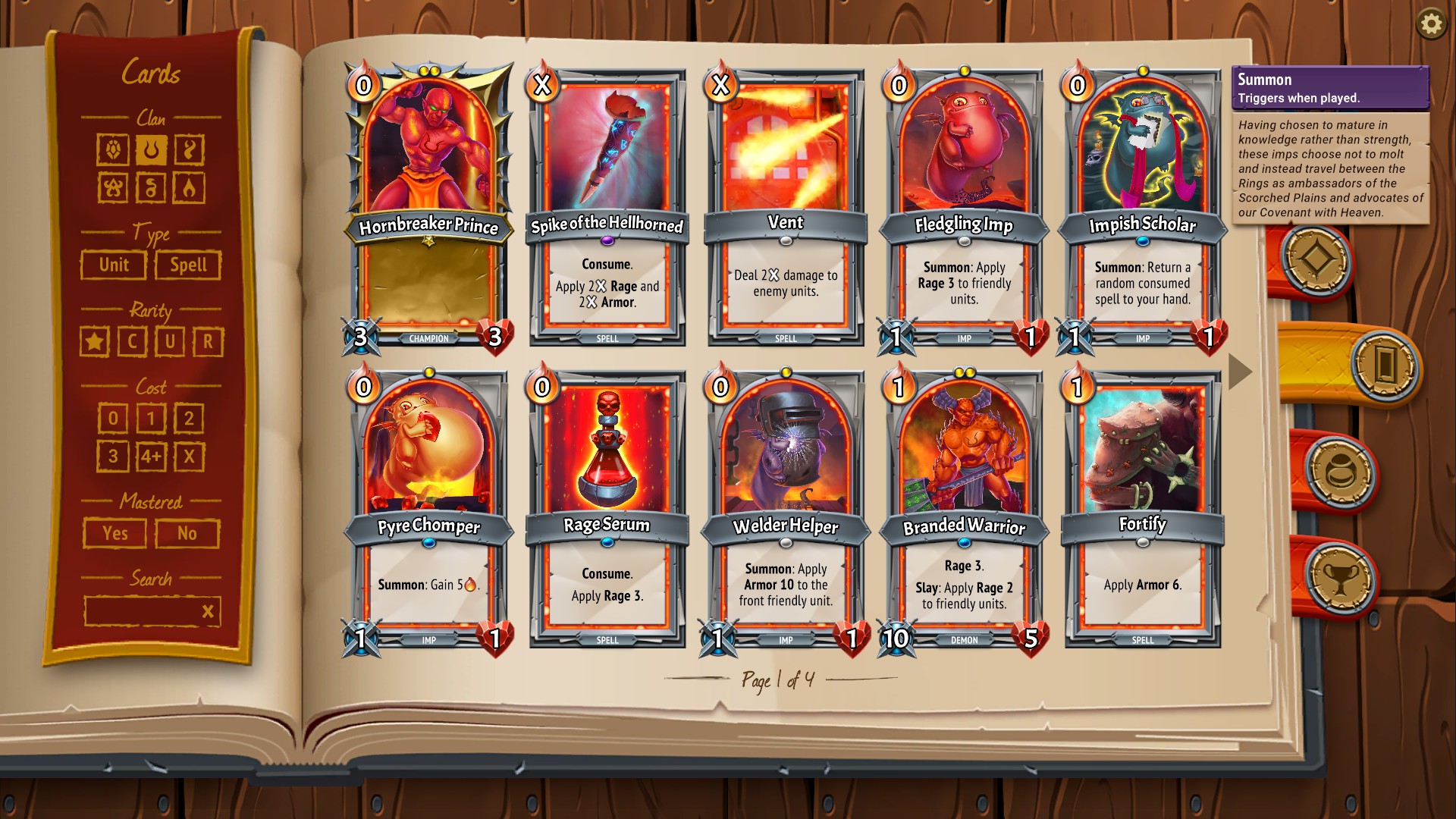
It may surprise you to hear that the game has a slightly dynamic soundtrack. When bosses appear, the current track gets more dramatic and heavy. In a soundtrack already littered with strings, brass, choir, harpsichords, and drums; it can make things feel appropriately biblical.
On top of that however, the soundtrack uses mechanical sounds with the tinking and clanging of metal to help settle you into the mechanical behemoth. It gives the game a little more identity in its soundtrack, and with constant replays you won’t tire of it.
There are also small soundbites for each creature, from small chirping to monstrous groans and roars. Speeding up battles might cause a machine gun of yelps, slashes, and smashes; but it never becomes overwhelming.
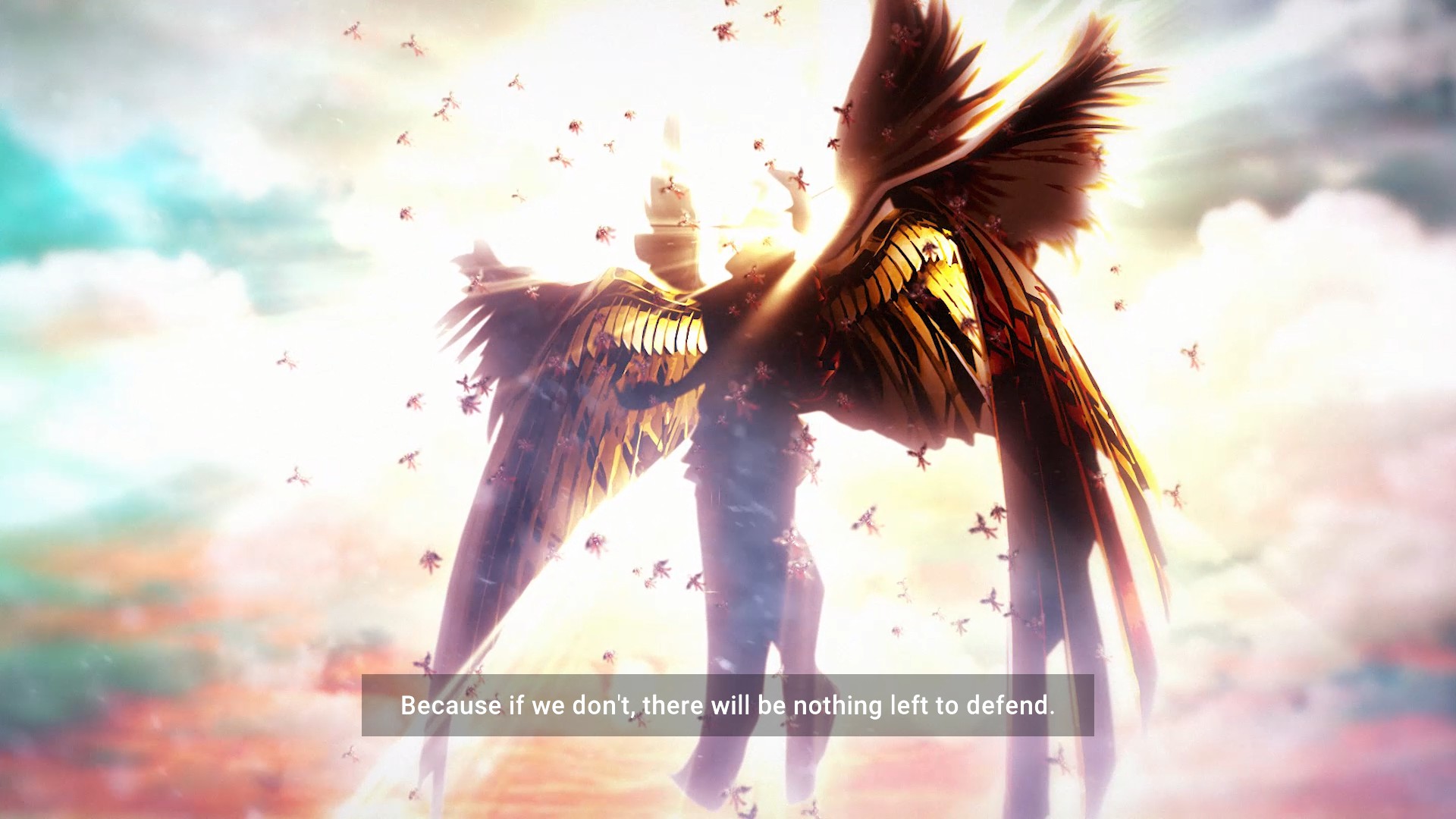
Monster Train encourages you to sink your teeth in and not let go. You can easily binge when you first pick it up, which will dictate whether you love it or hate it. You’ll either find it repetitive within the first few minutes, or end up playing until sunrise to get more win-streaks and personal bests.
If you have even a hint of love for card games of any kind, I cannot recommend Monster Train enough. I’m already hoping for more cards and clans in the future. If not, they’ll be hell to pay.
Monster Train was reviewed on Windows PC using a review copy provided by Good Shepherd Entertainment. You can find additional information about Niche Gamer’s review/ethics policy here.